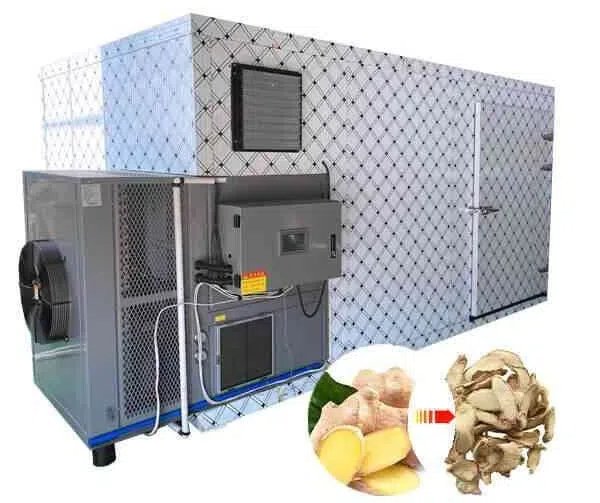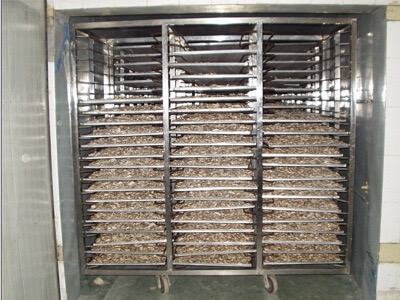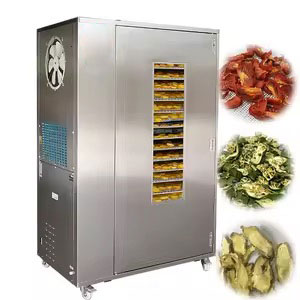
Content Menu
● Introduction to Ginger Dehydration Machines
>> Types of Ginger Dehydration Machines
● Key Features to Consider
>> 1. Temperature Control
>> 2. Drying Capacity
>> 3. Energy Efficiency
>> 4. Ease of Operation and Maintenance
>> 5. Hygiene and Safety
● Applications of Ginger Dehydration Machines
● Choosing the Right Machine for Your Business
● Maintenance and Troubleshooting
● Conclusion
● FAQ
>> 1. What is the typical temperature range for drying ginger?
>> 2. How long does it take to dry ginger in an industrial dehydrator?
>> 3. What are the advantages of using a heat pump dryer for ginger dehydration?
>> 4. What is the difference between a mesh belt dryer and a cabinet-type dryer?
>> 5. How do I ensure the hygiene and safety of the ginger dehydration process?
● Citations:
Choosing the right ginger dehydration machine is crucial for businesses involved in the production of dried ginger products. This article will guide you through the key factors to consider when selecting a ginger dehydration machine, including types of machines, features, and applications.

Introduction to Ginger Dehydration Machines
Ginger dehydration machines are specialized equipment designed to remove moisture from ginger, preserving its nutritional value and flavor. These machines are essential for producing high-quality dried ginger products, which are used in various industries such as food, pharmaceuticals, and cosmetics.
Types of Ginger Dehydration Machines
There are several types of ginger dehydration machines available, each with its unique features and advantages:
1. Heat Pump Dryers: These machines use heat pump technology to efficiently dry ginger at low temperatures, preserving its color and nutrients. They are energy-efficient and environmentally friendly.
2. Mesh Belt Dryers: These are continuous production dryers that use hot air to dry ginger. They are suitable for large-scale operations due to their high capacity and fast drying times.
3. Cabinet-Type Dryers: These are compact and easy to operate, suitable for smaller operations. They use heat pump technology for efficient drying.
4. Vacuum Dryers: These machines dry ginger under vacuum conditions, which helps preserve the delicate compounds and flavors of the ginger.
5. Freeze Dryers: Also known as lyophilizers, these machines freeze the ginger and then remove the moisture through a vacuum process. This method preserves the texture and flavor of the ginger.
Key Features to Consider
When choosing a ginger dehydration machine, several features are important to consider:
1. Temperature Control
A good ginger dehydration machine should have precise temperature control to ensure that the ginger is dried at the optimal temperature. This helps preserve the nutrients and flavor of the ginger.
2. Drying Capacity
The capacity of the machine should match your production needs. For large-scale operations, mesh belt dryers are often preferred due to their high output.
3. Energy Efficiency
Energy-efficient machines like heat pump dryers can significantly reduce operational costs over time.
4. Ease of Operation and Maintenance
The machine should be easy to operate and maintain. Features like automatic temperature control and simple cleaning processes are beneficial.
5. Hygiene and Safety
The machine should ensure that the drying process is hygienic and safe, preventing contamination and ensuring compliance with food safety standards.

Applications of Ginger Dehydration Machines
Ginger dehydration machines have a wide range of applications:
- Food Industry: Dried ginger is used in various food products such as spices, seasonings, and snacks. It is also used in traditional dishes and beverages.
- Pharmaceutical Industry: Dried ginger is used in herbal medicines due to its medicinal properties, such as anti-inflammatory and digestive benefits.
- Cosmetics Industry: Dried ginger is used in skincare products for its antioxidant properties, which help protect the skin from damage.
Choosing the Right Machine for Your Business
To choose the right ginger dehydration machine for your business, consider the following steps:
1. Assess Your Production Needs: Determine the volume of dried ginger you need to produce daily. This will help you decide between different types of machines based on their capacity.
2. Consider Your Budget: Evaluate your budget for the machine purchase and ongoing operational costs. Energy-efficient machines may have higher upfront costs but can save money in the long run.
3. Evaluate Space and Infrastructure: Ensure you have enough space for the machine and the necessary infrastructure, such as power supply and ventilation.
4. Research Suppliers: Look for reputable suppliers that offer quality machines and reliable customer service.
5. Test the Machine: If possible, test the machine with a small batch of ginger to ensure it meets your quality standards.
Maintenance and Troubleshooting
Regular maintenance is crucial to extend the lifespan of your ginger dehydration machine and ensure optimal performance. Here are some tips:
- Regular Cleaning: Clean the machine regularly to prevent buildup and contamination.
- Check for Wear and Tear: Regularly inspect parts for wear and tear and replace them as needed.
- Monitor Temperature and Humidity: Ensure that the machine operates within the recommended temperature and humidity ranges.
Conclusion
Choosing the right ginger dehydration machine is crucial for businesses looking to produce high-quality dried ginger products. By considering factors such as temperature control, drying capacity, energy efficiency, ease of operation, and hygiene, businesses can select a machine that meets their specific needs. Whether it's for the food, pharmaceutical, or cosmetics industry, the right ginger dehydration machine can enhance product quality and efficiency.

FAQ
1. What is the typical temperature range for drying ginger?
The typical temperature range for drying ginger is between 40°C to 80°C, depending on the type of machine and desired quality of the dried product.
2. How long does it take to dry ginger in an industrial dehydrator?
Drying ginger in an industrial dehydrator typically takes between 7 to 16 hours, depending on the thickness of the ginger slices and the dehydrator settings.
3. What are the advantages of using a heat pump dryer for ginger dehydration?
Heat pump dryers offer advantages such as energy efficiency, preservation of nutrients, and low operating costs. They are also environmentally friendly.
4. What is the difference between a mesh belt dryer and a cabinet-type dryer?
Mesh belt dryers are designed for continuous large-scale production, while cabinet-type dryers are more compact and suitable for smaller operations. Mesh belt dryers use hot air, while cabinet-type dryers often use heat pump technology.
5. How do I ensure the hygiene and safety of the ginger dehydration process?
To ensure hygiene and safety, use a machine with a closed drying system, follow proper cleaning protocols, and adhere to food safety standards.
Citations:
[1] https://airtekdehydrator.com/blog/choosing-best-commercial-food-dehydrator/
[2] https://littlegreendot.com/dehydrator-buying-guide/
[3] https://www.bxdrymachine.com/ginger-drying-machine.html
[4] https://www.gingerprocess.com/automatic-dehydrated-ginger-slice-production-line/
[5] https://www.bxdrymachine.com/ginger-dryer.html
[6] https://www.gelgoogdryer.com/news/technical-blog/drying-ginger-in-dehydrator.html
[7] https://gingermachines.com/product/ginger-drying-machine/
[8] https://septree.com/blogs/news/how-to-choose-the-right-commercial-dehydrator-for-your-business-or-homestead
[9] https://www.joyingmachinery.com/more-material/ginger-dehydrator/
[10] https://www.bxdryer.com/news/industry-news/commercial-ginger-dryer.html
[11] https://www.ike.cn/ginger-drying-machine.html
[12] https://www.alibaba.com/showroom/ginger-dehydrator.html
[13] https://www.bxdryer.com/news/industry-news/ginger-processing-equipment-news.html
[14] https://www.dehydratorsamerica.com/dehydrating-recipes/ginger-powder
[15] https://www.made-in-china.com/products-search/hot-china-products/Ginger_Drying_Machine.html
[16] https://www.alibaba.com/product-detail/1000kg-Hour-Dried-Ginger-Drying-Making_1601127947110.html
[17] https://www.dodiamachines.com/portfolio/ginger-dehydration-plant/
[18] https://kinkaitech.com/ginger-drying-machine/
[19] https://www.youtube.com/watch?v=FT9LsoktL6E
[20] https://www.bxdryer.com/news/industry-news/how-to-dehydrate-ginger.html
[21] https://www.aimheatpump.com/pages-25591
[22] https://www.reddit.com/r/dehydrating/comments/11kewug/buying_a_dehydrator_share_your_tips_please/
[23] https://www.reddit.com/r/dehydrating/comments/16htjuv/anyone_own_a_commercial_dehydrator_or_know_of_any/
[24] https://www.mayboommachine.com/product/detail/16
[25] https://www.gelgoogdryer.com/product/ginger-drying-machine.html
[26] https://www.youtube.com/watch?v=7ZSbNT0HncQ
[27] https://www.gingerprocess.com/video/
[28] https://harvestright.com/v50/











